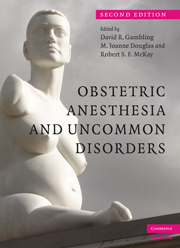Book contents
- Frontmatter
- Contents
- List of plates
- List of contributors
- Preface
- Section 1 Cardiovascular and respiratory disorders
- 1 Structural heart disease in pregnant women
- 2 Disorders of cardiac conduction
- 3 Vascular diseases
- 4 Respiratory disorders in pregnancy
- Section 2 Musculoskeletal disorders
- Section 3 Nervous system disorders
- Section 4 Metabolic disorders
- Section 5 Other disorders
- Index
- Plate Section
- References
3 - Vascular diseases
from Section 1 - Cardiovascular and respiratory disorders
Published online by Cambridge University Press: 19 October 2009
- Frontmatter
- Contents
- List of plates
- List of contributors
- Preface
- Section 1 Cardiovascular and respiratory disorders
- 1 Structural heart disease in pregnant women
- 2 Disorders of cardiac conduction
- 3 Vascular diseases
- 4 Respiratory disorders in pregnancy
- Section 2 Musculoskeletal disorders
- Section 3 Nervous system disorders
- Section 4 Metabolic disorders
- Section 5 Other disorders
- Index
- Plate Section
- References
Summary
Introduction
Maternal vascular lesions that become apparent during pregnancy may be present before conception but only become symptomatic as a result of the physiologic changes of pregnancy. Blood vessels are weakened by an increase in blood volume and cardiac output (CO); a decrease in systemic vascular resistance (SVR); and hormonal changes. Hence, aneurysms can expand and rupture, or arteriovenous (AV) malformations can grow and, if present in the pulmonary circulation, can worsen a preexisting shunt. Some of the rare conditions described in this chapter affect blood vessels in discrete areas of the body whereas others affect all blood vessels. Often the disorders described are part of an autoimmune disease process that impacts other organ systems. Many of the vascular disorders are associated with high maternal and neonatal mortality. For example, rupture of an enlarging aneurysm can cause abrupt, catastrophic blood loss and poor peripartum outcomes. Likewise, pulmonary hypertension worsens during pregnancy and is often associated with maternal and/or neonatal death. This chapter discusses the clinical implications for the obstetric anesthesiologist of most vascular lesions seen during pregnancy. Intracranial aneurysms during pregnancy are discussed in Chapter 9.
Primary pulmonary hypertension
Primary pulmonary hypertension is a progressive disease that produces a sustained rise of at least 25 mmHg in mean pulmonary artery pressure and an increase in pulmonary resistance, in the absence of an identified pulmonary or cardiac lesion. This inevitably leads to right ventricular (RV) dilatation and RV hypertrophy progressing to RV failure and death.
- Type
- Chapter
- Information
- Obstetric Anesthesia and Uncommon Disorders , pp. 57 - 74Publisher: Cambridge University PressPrint publication year: 2008



